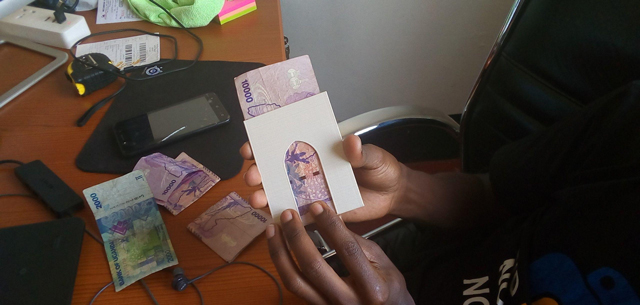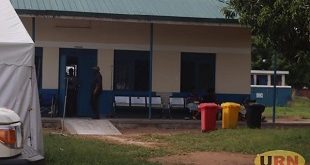
Soroti, Uganda | THE INDEPENDENT | Ralph Musiime, a visually impaired teacher in Gulu, is happy that he can now sort out his paper money, without involving another person, thanks to a three-dimensional 3D printed money identifier.
Unlike other countries such as Canada and India among others, Ugandan paper cash don’t have braille-like markings, to help the visually impaired easily identify them. This has made many visually impaired persons lose money to dishonest people while transacting business.
So, for years, Musiime, who lives with a colleague, also visually impaired, would have to go to his neighbour every morning, to seek help in sorting paper money, before heading out to eke a living, so that he is not cheated. However, recently, Erias Muhoozi, a tech-savvy Director in Charge of Technology, Training and Database Management at Oysters & Pearls-Uganda, devised a 3D printed money identifier, to solve the problem.
Muhoozi says that he devised the money identifier, after Moses Ayoli, a visually impaired teacher, explained the need to have something to help the visually impaired tell their notes apart. “He had the theoretical concept, and I developed the practical concept out of it. I thought of how it can be made in terms of design and measurements. So, the practical part of the idea, I did it.”
The money identifier is a wallet-size device made of only plastic. It has a pouch and cutting behind it, to help the user slot their money and pull it way down to the device, respectively, before folding it to determine its denomination. The front part of the device has six tactile lines, representing all the paper notes in Uganda. The lines were designedly drawn, such that if you fold a particular note, it ends on the line it was intended for.
Moses Ayoli, a teacher at Madera School for the Blind in Soroti, is happy that his idea will end up helping many people. He says the device should be made stronger so that it does not break. However, Muhoozi says the device can last at least five years, if well taken care of.
Muhoozi, says he printed the money identifier with the help of the organisation’s 3D printer. The small device is sold at 8,000 Shillings and the bigger one goes for 10,000, Shillings and is happy that the device is now able to solve the problem for which it was deigned.
“The visually impaired has always not of choice of keeping their finances secret, because they had to seek the help of someone else to identify their money. This has always exposed them to the risks of being cheated by dishonest people. This card was built to solve that problem.”
Musiime says the device has made him feel some sense of privacy regarding the amount he carries, adding that it is 100 per cent perfect if the user masters it.
“If I have different notes, I sit at my table and organize them myself, and it helps me a lot, as opposed to going to the neighbour. Because I live with Denish, and he also does not see. We always called the neighbour asking them to first arrange our money. This is 100 per cent accurate if you master how those lines are because the measurement has been done so well and they are accurate.”
Basil Onen Kolo, another user of the device, appreciates the idea that the device works independently without any digital aid or need to power it using a battery or charging. Onen explains that although there are digital money identifiers or applications on smartphones on the market, its use is limited, because digital literacy among the visually impaired in Uganda is a huge challenge that needs to be tackled separately. He says the fact that the money identifier has been printed using biodegradable material, is a plus.
Onen however says the device cannot be used in a bank or market setting, because of the process involved. While using the device, one has to slot a note at a time, which he says takes time. “The device is good for use at home, where the user takes their time to sort their money in easily recognizable denominations. But in a bank, people might become impatient with you.”
********
URN
 The Independent Uganda: You get the Truth we Pay the Price
The Independent Uganda: You get the Truth we Pay the Price



